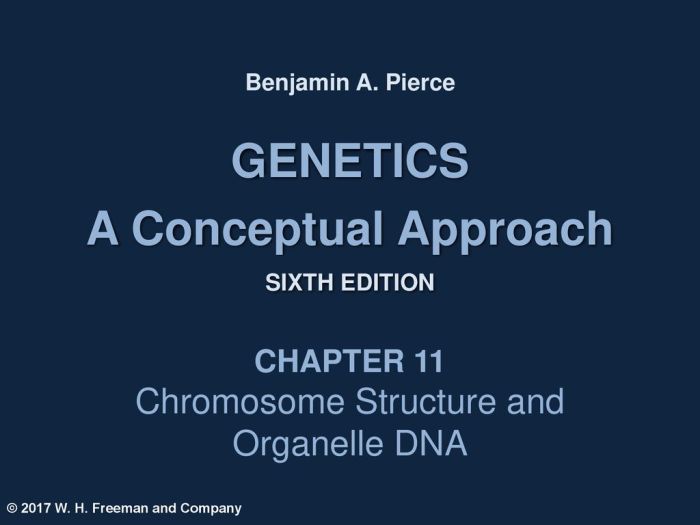Genetics a conceptual approach sixth edition – Embark on a captivating journey with Genetics: A Conceptual Approach, Sixth Edition, where the intricate world of genetics unfolds before your eyes. This comprehensive guide delves into the historical roots and evolution of genetics, illuminating the groundbreaking discoveries that have shaped our understanding of life’s building blocks.
From the fundamental principles of inheritance to the cutting-edge advancements in genetic technologies, this text provides a comprehensive overview of the field. Explore the molecular basis of inheritance, unravel the mechanisms of gene expression and regulation, and delve into the ethical considerations surrounding genetic testing and information.
Historical Context and Evolution of Genetics

The study of genetics has a rich history that has been shaped by key figures and technological advancements. The field traces its roots to the work of Gregor Mendel in the mid-19th century, who established the basic principles of inheritance.
Key Figures and Contributions
- Gregor Mendel:Established the laws of inheritance through experiments with pea plants.
- Thomas Hunt Morgan:Studied fruit flies and identified the role of chromosomes in inheritance.
- James D. Watson and Francis Crick:Discovered the structure of DNA in 1953.
- Frederick Sanger:Developed DNA sequencing techniques.
- Kary Mullis:Invented the polymerase chain reaction (PCR) for amplifying DNA.
Impact of Technological Advancements
- Microscopy:Enabled scientists to observe chromosomes and cell division.
- DNA sequencing:Revolutionized genetics by allowing researchers to read the genetic code.
- PCR:Facilitated the rapid amplification of DNA samples.
- Gene editing techniques (e.g., CRISPR-Cas9):Empowered scientists to make precise changes to DNA.
Basic Principles of Inheritance

Inheritance refers to the transmission of genetic traits from parents to offspring. Mendelian principles, named after Gregor Mendel, form the foundation of understanding inheritance patterns.
Mendelian Principles
- Law of Segregation:Each parent contributes one allele for each gene, and these alleles segregate during gamete formation.
- Law of Independent Assortment:Alleles for different genes assort independently of each other during gamete formation.
Molecular Basis of Inheritance
DNA, a double-stranded molecule, is the genetic material responsible for transmitting hereditary information. Genes are specific regions of DNA that code for proteins.
Genetic Variation
Genetic variation arises from changes in DNA, such as mutations, deletions, and insertions. This variation is essential for evolution and adaptation.
Gene Expression and Regulation: Genetics A Conceptual Approach Sixth Edition

Gene expression refers to the process by which the information encoded in genes is used to produce proteins. This process involves transcription, translation, and regulation.
Gene Expression
- Transcription:DNA is transcribed into messenger RNA (mRNA) in the nucleus.
- Translation:mRNA is translated into proteins in the cytoplasm.
Gene Regulation, Genetics a conceptual approach sixth edition
Gene expression is regulated at various levels, including transcriptional control and post-translational modifications. Transcriptional control involves mechanisms such as promoters, enhancers, and repressors.
Epigenetics
Epigenetics refers to heritable changes in gene expression that do not involve changes in the DNA sequence. These changes can influence gene expression patterns and contribute to phenotypic diversity.
FAQ Guide
What is the central theme of Genetics: A Conceptual Approach, Sixth Edition?
The text provides a comprehensive overview of genetics, covering its historical development, basic principles, molecular techniques, genetic disorders, evolution, and applications in biotechnology.
How does this edition differ from previous editions?
The sixth edition incorporates the latest advancements in genetic research, including CRISPR-Cas9 gene editing and the role of epigenetics in gene expression.
Who is the intended audience for this book?
Genetics: A Conceptual Approach, Sixth Edition, is suitable for undergraduate students in biology, genetics, and related fields, as well as general readers interested in gaining a deeper understanding of genetics.